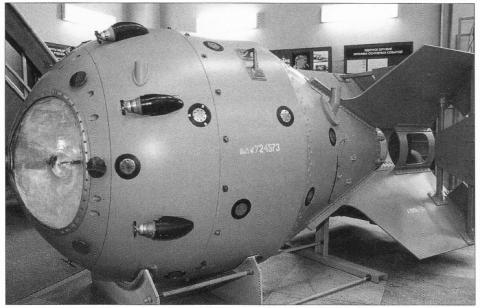Soviet physicists paid close attention to the news of the discovery of fission in Germany in 1938. Throughout 1939, leading Soviet physicists attempted to reproduce the fission experiment that Otto Hahn and Fritz Strassmann had conducted in Berlin and began to make measurements and calculations to determine under exactly what conditions, if any, a nuclear chain reaction would take place.
After Germany invaded the Soviet Union in 1941, Soviet nuclear physics work largely ceased. Scientists and engineers were drafted or assigned to work on projects, such as radar, that were seen as more pressing. However, a small fraction of physicists continued to explore the possibilities of uranium. Peter L. Kapitza, a high-ranking physicist, remarked in October 1941 that the recent discovery of nuclear energy could be useful in the war against Germany and that the prospects of a uranium bomb seemed promising. Soviet leaders learned that both the United States and Germany had embarked on efforts to build an atomic bomb. In February 1943, the Soviets began their own program led by nuclear physicist Igor Kurchatov and political director Lavrentiy Beria.
The Soviet Atomic Bomb during World War II
.gif)
Director Igor Kurchatov.
The Soviet atomic program during the war was puny compared to the Manhattan Project, involving approximately twenty physicists and only a small number of staff. They researched the reactions necessary to produce both atomic weapons and nuclear reactors. They also began exploring ways to generate enough pure uranium and graphite, and researched uranium isotope separation methods.
Work on the program sped up quickly in 1945, however, especially after the Soviets learned of the Trinity test. At the Potsdam Conference in July 1945, Truman told Joseph Stalin about the United States atomic bomb program for the first time. According to Truman, “I casually mentioned to Stalin that we had a new weapon of unusual destructive force. The Russian Premier showed no special interest. All he said was he was glad to hear it and hoped we would make good use of it against the Japanese.”
While Stalin may have appeared uninterested, he privately told his top advisers to speed up work on the Soviet atomic program: “They simply want to raise the price. We’ve got to work on Kurchatov and hurry things up.”
The Soviet regime immediately stepped up their program. General Boris L. Vannikov (who has been compared to General Leslie Groves) headed an engineering council that oversaw the project. Its members included Kurchatov, M.G. Pervukhin, A.I. Alikhanov, I.K. Kikoin, A.P. Vinovgradov, Abram Joffe, A.A. Bochvar, and Avraamy Zavenyagin.
Following the bombings of Hiroshima and Nagasaki, Stalin called for an all-out crash program in atomic research and development. In 1946 Yuli Khariton was appointed by Kurchatov as the program’s lead scientist. He was tasked with directing atomic research, development, design, and weapons assembly, and helped select and establish the site of the secret Soviet nuclear weapons facility, known as Arzamas-16 and nicknamed “Los Arzamas.
The Soviet Atomic Bomb and the Cold War
On December 25, 1946, the Soviets created their first chain reaction in a graphite structure similar to Chicago Pile-1. After encountering some difficulties with the production of plutonium and the isotopic separation of uranium over the next two years, Soviet scientists managed to get their first production reactor working satisfactorily in the fall of 1948. It would only be a matter of months before the U.S.S.R. exploded its own atomic bomb. The Soviets successfully tested their first nuclear device, called RDS-1 or “First Lightning” (codenamed “Joe-1” by the United States), at Semipalatinsk on August 29, 1949.
As the Cold War intensified, both the Soviet Union and the United States embarked upon efforts to rapidly develop and grow their respective nuclear arsenals. Shortly after the US launched its hydrogen bomb program in the early 1950s, the USSR followed suit and initiated their own hydrogen bomb program.
Espionage

Klaus Fuchs Los Alamos ID Badge.
Contrary to popular belief, there was no concrete “secret” behind the atomic bomb. The discovery of fission in 1938 meant that a nuclear chain reaction was possible and that the energy produced from this process could be used to produce a weapon of unusual force. Physicists like J. Robert Oppenheimer, Enrico Fermi, and Leo Szilard knew that it was only a matter of time before other countries were able to develop their own atomic weapons. The only secret behind the bombs lay in their specifications, material composition, and inner workings. Any government with the determination and the resources to develop an atomic weapon could do so within a matter of time.
When Klaus Fuchs‘s espionage was discovered in 1950, many believed that his actions had been essential to the Soviet bomb. Fuchs did pass along important information about the bomb’s design and technical specifications, and the Congressional Joint Committee on Atomic Energy concluded that “Fuchs alone has influenced the safety of more people and accomplished greater damage than any other spy not only in the history of the United States but in the history of nations.” However, there has been much debate surrounding the role of espionage in the Soviet Union’s atomic program. Scholarship suggests that Soviet spying probably allowed the USSR to develop an atomic bomb six months to two years faster than they would have had there been no espionage.





